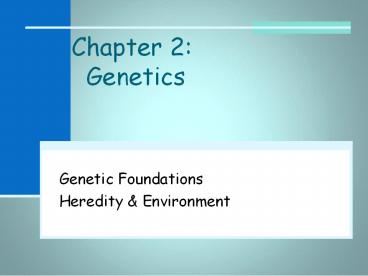Chapter 2: Genetics PowerPoint PPT Presentation
1 / 28
Title: Chapter 2: Genetics
1
Chapter 2 Genetics
- Genetic Foundations
- Heredity Environment
2
Genetic Foundations
- Chromosomes limits
- Each of us carries a genetic code that we
inherited from our parents. Because a fertilized
egg carries this human code, a fertilized human
egg cannot grow into an egret, eagle, or
elephant.
3
Genetics and Behavior
4
Genes Our Biological Blueprint
- Human Genome Project
- Initial phase completed about the year 2000
- Humans have 20,000 25, 000 genes (21,667)
- There are far more proteins than genes 10-20
million - Genes (DNA) are dependent- collaborate with other
sources of information - Gene expression/activity is affected by context
or environment - Context is affected by hormones, light,
nutrition, etc.
5
The Sex Cells
- Sex cells are formed by meiosis rather than
mitosis. - Gametes (sperm and ova) have only 23 chromosomes
total. - At conception, these two unite resulting in a
full complement of 46 chromosomes (23 pairs). - A fertilized egg is called a zygote.
6
Sources of Genetic Variation
- Alleles are normal variations of a gene, found at
the same location. - A child who inherits the same allele (type of
gene) from both parents is homozygous for that
trait. - A child who inherits different alleles from each
parent is heterozygous for that trait.
7
Sources of Variation
- Genetic Expression
- Influenced by the environment
- hormones
- light
- nutrition
- behavior
- stress (cortisol may cause a fivefold increase
in DNA damage)
8
Sources of Genetic Variation
- Patterns of Genetic Inheritance
- Dominant-recessive the dominant gene (allele)
will determine the characteristic
9
Patterns of Genetic InheritanceDominant-recessive
inheritance
- Examples of dominant genes
- Dark hair, curly hair, dimples, types A B blood
(vs. type O), traits for normality in vision,
hearing, pigmentation, etc. - Huntingtons Disease
10
Patterns of Genetic InheritanceDominant-recessive
inheritance
- Examples of recessive genes
- Cystic fibrosis, PKU, Tay-sachs disease.
Sickle-cell anemia
11
Patterns of Genetic InheritanceCo-dominance and
Additive
- Co-dominance both alleles contribute to the
phenotype, although not to the same degree. - Additive They contribute about equally
(50-50). - Example of Co-dominance
- Sickle-cell anemia
12
X-linked (sex-linked) inheritance
- Female children receive an X chromosome from the
father which matches locations on the mothers X. - Male children receive a Y from the father, which
does not have all the gene locations of an X. - The defective gene on the mothers X is offset by
the gene on the normal X in females, but not in
males. - So, males will show evidence of the defective
gene (e.g., hemophilia, RG colorblindness). - Females will be normal, but carriers of the
defective gene.
13
Polygenic Inheritance
- Many genes interact to influence the
characteristic - Most psychological characteristics are polygenic
- (Where environmental factors are included, traits
are said to be multi-factorial.)
14
Chromosomal Abnormalities
- Usually happen during meiosis
- Involve breakage and failure to separate
- Usually result in miscarriage
- Those most commonly survived are
- Down syndrome (trisomy 21)
- Sex-linked abnormalities
15
Sex Chromosome Abnormalities
- XXY (Klinefelter) may have verbal difficulties.
Tall, underdeveloped testes, possible breasts.
1/800 live male births. - XO (Turner) have trouble with math and spatial
skills. Short and have webbed neck may be
infertile. 1/2500 live female births - XYY (Are they more aggressive, antisocial?)
16
Gene-linked Abnormalities
- Over 7000 known (most rare), including
- Cystic fibrosis
- Diabetes
- Hemophilia
- Huntington
- PKU (phenylketonuria)
- Sickle-cell anemia
- Spina bifida
- Tay-sachs disease
17
Genetic Counseling for whom?
- Family history of disease, mental retardation,
physical defects - History of miscarriages
- Mother over age 35 (rate of abnormality begins to
rise sharply)
18
Prenatal Diagnostic Methods
- May cause miscarriage (except ultrasound,
maternal blood samples) - Is the problem correctible?
- Genetic engineering is still in the future.
- Often the only decision is whether or not to
abort the fetus.
19
Prenatal Diagnostic Methods
- Chorionic villi sampling (6-8 weeks)
- detects genetic defects risk of miscarriage,
limb deformity - Amniocentesis (11 weeks, best after 15 weeks)
detects genetic defects smaller risk of
miscarriage
20
Infertility
- 1 in 6 couples in U.S.
- Waiting too late
- Sexually transmitted diseases
- Fertility technology (IVF, donors)
- Adoption
- Babies culturally unavailable
21
Environmental Influence
22
Environmental Influence
- Rats reared in an environment enriched with
playthings show increased development of the
cerebral cortex
23
Twins
- Identical Twins
- develop from a single fertilized egg that splits
in two, creating two genetically identical
organisms - Fraternal Twins
- develop from separate eggs
- genetically no closer than brothers and sisters,
but they share a fetal environment
24
Multiple Births fraternal twins
- Dizygotic (two zygotes)
- Share approximately 50 of their genetic heritage
like any two siblings. - Major causes are maternal age and fertility
drugs. - Twinning dramatically on the increase since the
1970s.
25
Multiple Births identical twins
- Monozygotic one zygote (same fertilized egg)
- Share 100 of genetic heritage
- Occurs about 3 per 1000 live births worldwide
- Factors may include temperature and oxygen levels
and late fertilization
26
Genetics Research
- Behavior Genetics
- study of the power and limits of genetic and
environmental influences on behavior - Molecular Genetics
- subfield of biology that studies the molecular
structure and function of genes
27
Nature-nurture Research
- Molecular genetics
- Human Genome Project
- Behavioral genetics
- Twin studies
- Equal environment assumptions
- Adoption studies
- Concordance rates
28
Epigenesis ongoing nature/nurture exchanges
(bi-directional)
- Reaction range
- Canalization
- Genetic-environmental correlation
- Passive
- Evocative
- Active (niche-picking)

